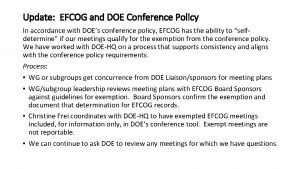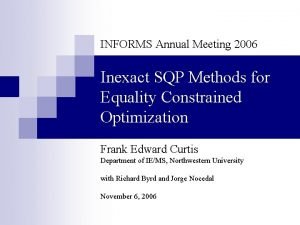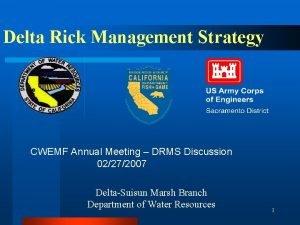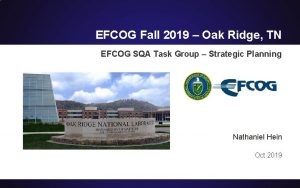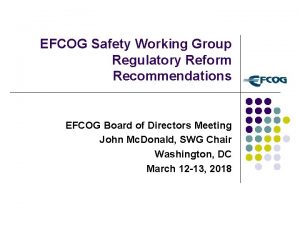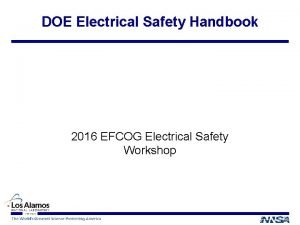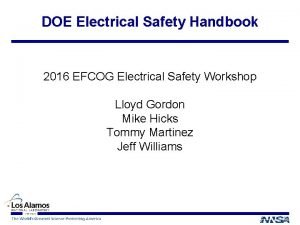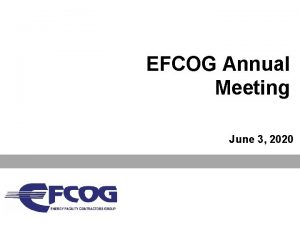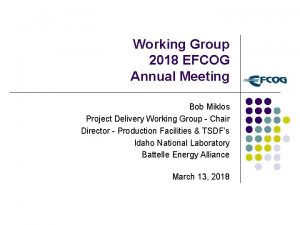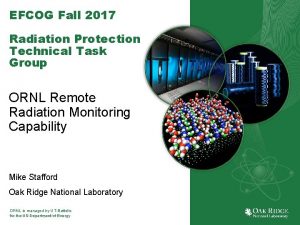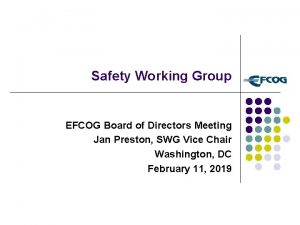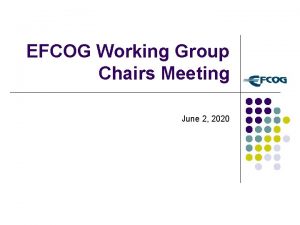2017 EFCOG Annual Meeting at DOE Project Management














- Slides: 14

2017 EFCOG Annual Meeting at DOE Project Management Career Development Program (PMCDP) Key Elements Linda Ott Professional Development Division Chief PM/DOE 1

PMCDP aligns with DOE Order 413. 3 B • Program has been in place at DOE since 2001 and was Congressionally mandated • Primary goals of PMCDP are: • To ensure the DOE has well qualified and experienced Federal Project Directors (FPDs) to oversee the agency's diverse portfolio of highly-technical construction, experimental equipment and environmental cleanup projects • To provide FPDs with the tools and training necessary to deliver projects that meet pre-defined scope, schedule and budgetary requirements, while maintaining the safety and security of these capital assets. June 2017 EFCOG Annual Meeting 2

PMCDP is Competency-Based (Training or Experience) Depending on the FPD level, must demonstrate familiarity-, working-, or expert-level knowledge of listed competencies: (Total of 62 competencies) General Project (8) Management Time (Schedule) (3) Management Leadership/Team Building (5) Risk Management (3) Scope Management (4) Contract Management (6) Communication (3) Management Integration Management (5) Quality/Safety (3) Management Related Course Electives (13) Cost Management (4) Behavioral (5) Work and Developmental Requirements June 2017 EFCOG Workshop at DOE 3

PMCDP: A SWOT Analysis • Strengths • FPD Statistics are steady at ~300 • More virtual deliveries • Content for course materials now posted on PM-MAX • Weaknesses • Refresher training, particularly training related to Order 413. 3 B • Training in line with PM policies and guide updates • Opportunities • PMCDP Review • Threats • KEY Challenges March 2017 DOE Project Management Workshop 4

Strengths for PMCDP • Steady at ~ 300 FPDs • Virtual Deliveries are working • Classes are full with average class size around 20 • Classroom training is more difficult to keep current • Communication improvements • GAO High-risk list now includes projects at NNSA and EM with TPC > $750 M 5

Weaknesses for PMCDP • Is training tracking with Project Management Policies and project management maturity? • Is relevant policy information being successfully implemented in training and FPD development? • It’s time to take a good look at the PMCDP. 6

Opportunity: PMCDP Review • Validate the critical success factors for an FPD and assess Program against them • Determine if 413 -series guides are adequately integrated into the training curriculum • Determine if training curriculum adequately addresses FPD roles & responsibilities • Determine strengths and opportunities for improvement 7

Program Review Timeline Subtask #1 Background 2/24/2017 Subtask #2 FPD Roles & Responsibilities Subtask #3 FPD Competencies Subtask #4 Guides & Courses 3/17/2017 4/28/2017 6/9/2017 Subtask #5 Strategic Plan 7/7/2017 8

Threats (Challenges) for PMCDP • Getting level III & IV FPDs at the right location on the right project at the right time (i. e. , Carlsbad, WTP, SWPF, etc. ) • Overall we have enough FPDs, yet not within Programs at specifically needed levels • Mobility and community management challenges • Currency of knowledge • Ease of application –documenting competencies and experience 9

Subtask #1 • State the PMCDP background, history, documents, and performance data Goal Provide one narrative describing how PMDCP was formed, bringing together the many historical, background, and performance documents since its inception. History of DOE’s PMCDP is Completed and posted on PM-MAX’s PMCDP page. 10

Subtask #2 • Validate the Federal Project Director (FPD) Critical Success Factors (CSFs) Goal Provide comprehensive listing of roles and responsibilities for the Federal Project Director. Critical Success Factors (CSFs) for DOE’s FPDs is posted on PM-MAX’s PMCDP page. 11

Subtask #3 • Analyze the Critical Success Factors (CSFs) against the existing competencies in the Certification and Equivalency Guidelines (CEG) Goal Update the competencies required of a Federal Project Director (FPD), based on the roles and responsibilities demanded of them. FPD Competency Model is posted on PM-MAX’s PMCDP page. 12

Subtask #4 • Compare the Critical Success Factors (CSFs) to existing curriculum and 413 -series guides Goal Provide a gap analysis of the PMCDP curriculum and 413 series guides, based on the roles and responsibilities demanded of the Federal Project Director (FPD). 13

Subtask #5 • Provide the “To-Be” state and proposed implementation plan Goal Provide a proposed plan and timeline that implements the findings and recommendations from the program review. 14
 Doe
Doe American epilepsy society annual meeting 2017
American epilepsy society annual meeting 2017 Efcog
Efcog Efcog best practices
Efcog best practices Efcog
Efcog 2017 dvhimss annual fall conference
2017 dvhimss annual fall conference Informs annual meeting
Informs annual meeting Aupha annual meeting
Aupha annual meeting American psychiatric association annual meeting 2020
American psychiatric association annual meeting 2020 Grand lodge of ky
Grand lodge of ky Annual theory meeting
Annual theory meeting Cwemf
Cwemf How to run an annual general meeting
How to run an annual general meeting Nrg oncology meeting 2019
Nrg oncology meeting 2019 Aashto annual meeting 2015
Aashto annual meeting 2015
